Analysis of Mary's Case Study: Infected Foot Laceration and Treatment
VerifiedAdded on 2023/06/10
|8
|2207
|194
Case Study
AI Summary
This case study examines the clinical presentation of Mary, a 21-year-old patient with an infected laceration on her left foot. The analysis delves into the physiological basis of the wound, considering the torn and jagged appearance of the laceration and the subsequent infection, which manifested as swelling, pain, and purulent discharge. The study explores potential sources of contamination, differentiating between endogenous sources like Staphylococcus aureus and exogenous sources such as Pseudomonas aeruginosa, and elucidates their respective modes of transmission. Furthermore, the rationale behind the choice of antibiotics, including ceftriaxone, cephalexin, and dicloxacillin, is discussed, along with the adverse reactions associated with dicloxacillin. Finally, the process of wound healing, encompassing the inflammatory, proliferative, and maturation phases, is outlined, emphasizing the role of antibiotic intervention in managing the infection and facilitating the healing process. The case study is a comprehensive analysis of the patient's condition, treatment, and expected recovery, providing a valuable educational resource for healthcare students.
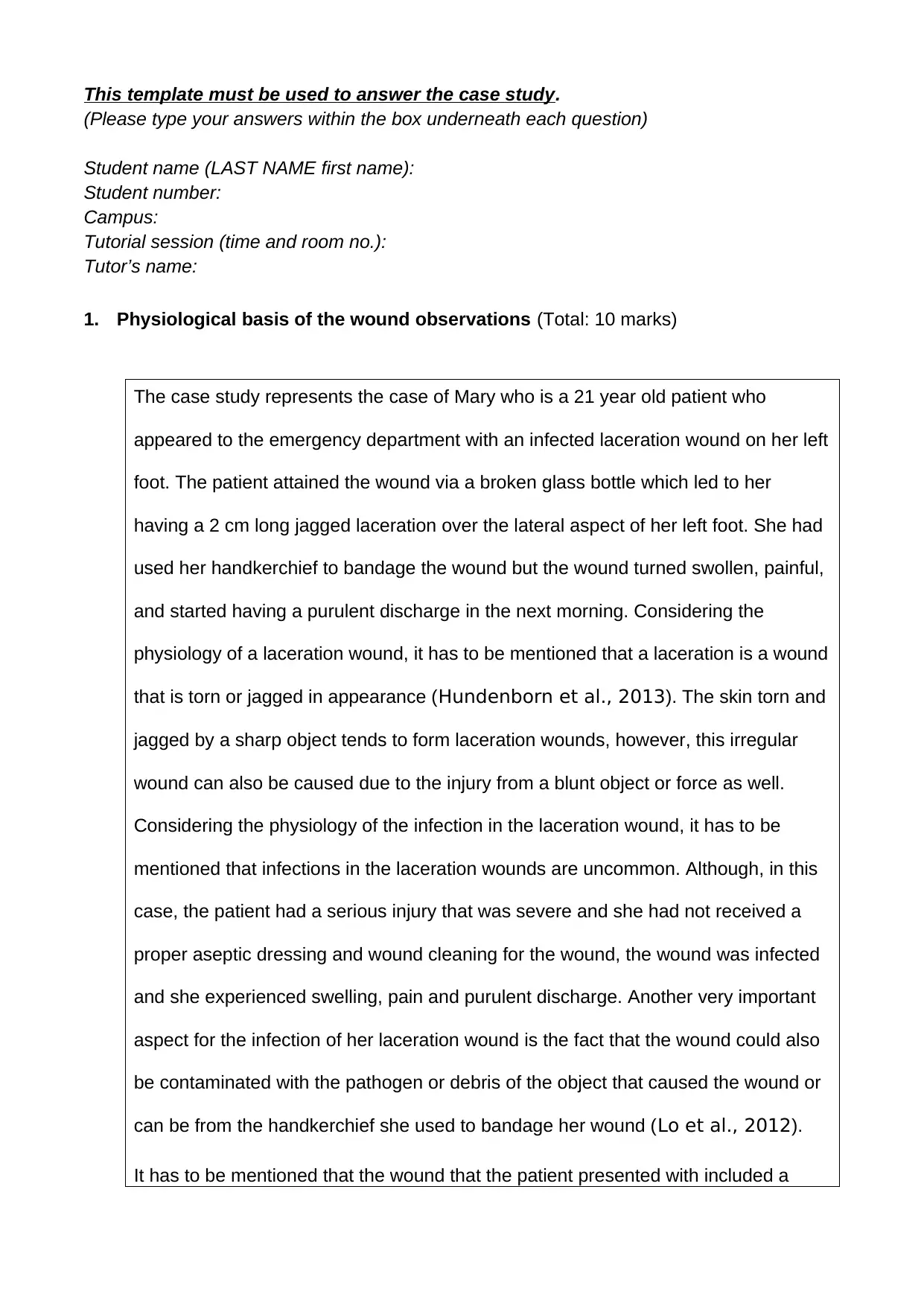
This template must be used to answer the case study.
(Please type your answers within the box underneath each question)
Student name (LAST NAME first name):
Student number:
Campus:
Tutorial session (time and room no.):
Tutor’s name:
1. Physiological basis of the wound observations (Total: 10 marks)
The case study represents the case of Mary who is a 21 year old patient who
appeared to the emergency department with an infected laceration wound on her left
foot. The patient attained the wound via a broken glass bottle which led to her
having a 2 cm long jagged laceration over the lateral aspect of her left foot. She had
used her handkerchief to bandage the wound but the wound turned swollen, painful,
and started having a purulent discharge in the next morning. Considering the
physiology of a laceration wound, it has to be mentioned that a laceration is a wound
that is torn or jagged in appearance (Hundenborn et al., 2013). The skin torn and
jagged by a sharp object tends to form laceration wounds, however, this irregular
wound can also be caused due to the injury from a blunt object or force as well.
Considering the physiology of the infection in the laceration wound, it has to be
mentioned that infections in the laceration wounds are uncommon. Although, in this
case, the patient had a serious injury that was severe and she had not received a
proper aseptic dressing and wound cleaning for the wound, the wound was infected
and she experienced swelling, pain and purulent discharge. Another very important
aspect for the infection of her laceration wound is the fact that the wound could also
be contaminated with the pathogen or debris of the object that caused the wound or
can be from the handkerchief she used to bandage her wound (Lo et al., 2012).
It has to be mentioned that the wound that the patient presented with included a
(Please type your answers within the box underneath each question)
Student name (LAST NAME first name):
Student number:
Campus:
Tutorial session (time and room no.):
Tutor’s name:
1. Physiological basis of the wound observations (Total: 10 marks)
The case study represents the case of Mary who is a 21 year old patient who
appeared to the emergency department with an infected laceration wound on her left
foot. The patient attained the wound via a broken glass bottle which led to her
having a 2 cm long jagged laceration over the lateral aspect of her left foot. She had
used her handkerchief to bandage the wound but the wound turned swollen, painful,
and started having a purulent discharge in the next morning. Considering the
physiology of a laceration wound, it has to be mentioned that a laceration is a wound
that is torn or jagged in appearance (Hundenborn et al., 2013). The skin torn and
jagged by a sharp object tends to form laceration wounds, however, this irregular
wound can also be caused due to the injury from a blunt object or force as well.
Considering the physiology of the infection in the laceration wound, it has to be
mentioned that infections in the laceration wounds are uncommon. Although, in this
case, the patient had a serious injury that was severe and she had not received a
proper aseptic dressing and wound cleaning for the wound, the wound was infected
and she experienced swelling, pain and purulent discharge. Another very important
aspect for the infection of her laceration wound is the fact that the wound could also
be contaminated with the pathogen or debris of the object that caused the wound or
can be from the handkerchief she used to bandage her wound (Lo et al., 2012).
It has to be mentioned that the wound that the patient presented with included a
Paraphrase This Document
Need a fresh take? Get an instant paraphrase of this document with our AI Paraphraser
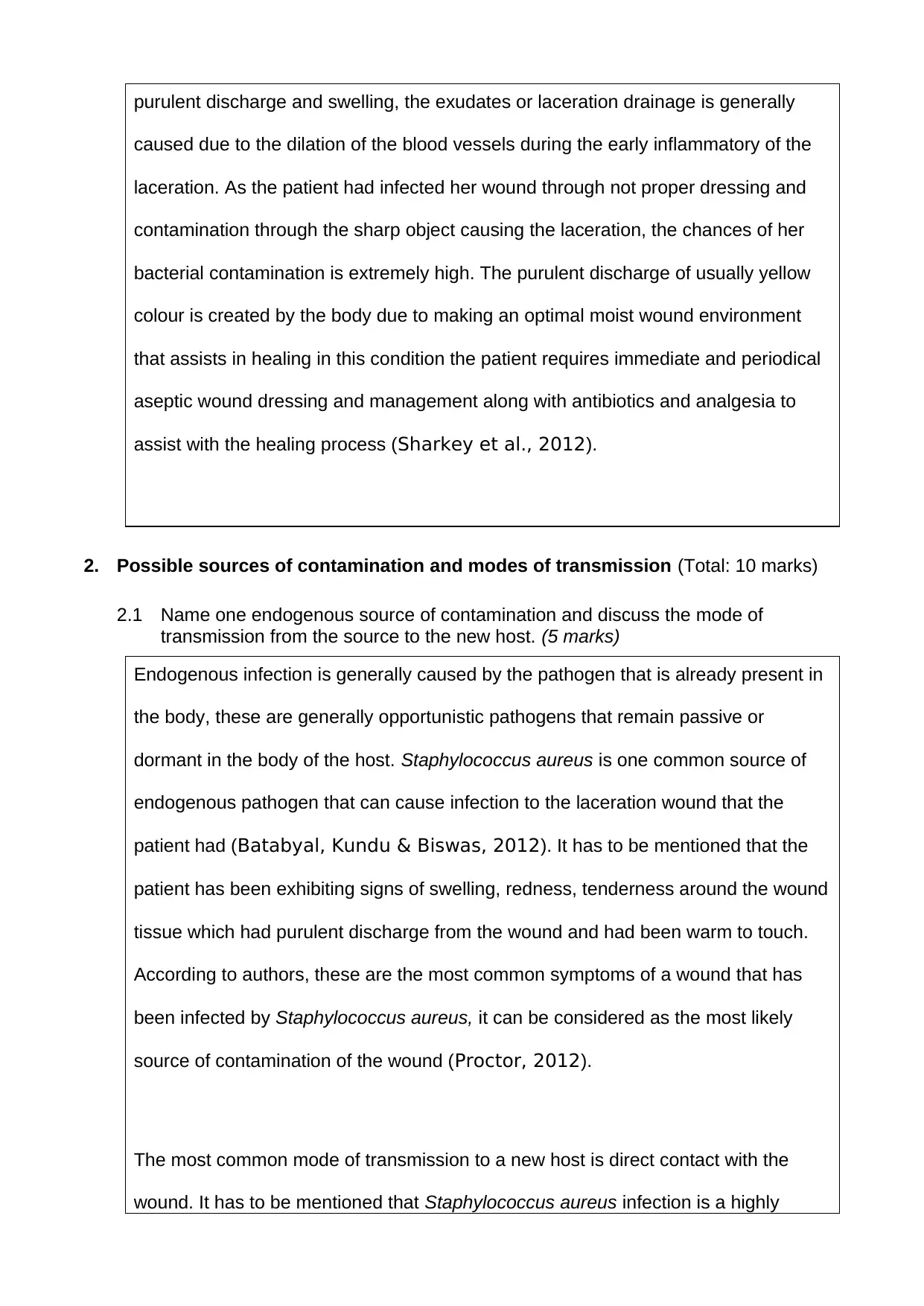
purulent discharge and swelling, the exudates or laceration drainage is generally
caused due to the dilation of the blood vessels during the early inflammatory of the
laceration. As the patient had infected her wound through not proper dressing and
contamination through the sharp object causing the laceration, the chances of her
bacterial contamination is extremely high. The purulent discharge of usually yellow
colour is created by the body due to making an optimal moist wound environment
that assists in healing in this condition the patient requires immediate and periodical
aseptic wound dressing and management along with antibiotics and analgesia to
assist with the healing process (Sharkey et al., 2012).
2. Possible sources of contamination and modes of transmission (Total: 10 marks)
2.1 Name one endogenous source of contamination and discuss the mode of
transmission from the source to the new host. (5 marks)
Endogenous infection is generally caused by the pathogen that is already present in
the body, these are generally opportunistic pathogens that remain passive or
dormant in the body of the host. Staphylococcus aureus is one common source of
endogenous pathogen that can cause infection to the laceration wound that the
patient had (Batabyal, Kundu & Biswas, 2012). It has to be mentioned that the
patient has been exhibiting signs of swelling, redness, tenderness around the wound
tissue which had purulent discharge from the wound and had been warm to touch.
According to authors, these are the most common symptoms of a wound that has
been infected by Staphylococcus aureus, it can be considered as the most likely
source of contamination of the wound (Proctor, 2012).
The most common mode of transmission to a new host is direct contact with the
wound. It has to be mentioned that Staphylococcus aureus infection is a highly
caused due to the dilation of the blood vessels during the early inflammatory of the
laceration. As the patient had infected her wound through not proper dressing and
contamination through the sharp object causing the laceration, the chances of her
bacterial contamination is extremely high. The purulent discharge of usually yellow
colour is created by the body due to making an optimal moist wound environment
that assists in healing in this condition the patient requires immediate and periodical
aseptic wound dressing and management along with antibiotics and analgesia to
assist with the healing process (Sharkey et al., 2012).
2. Possible sources of contamination and modes of transmission (Total: 10 marks)
2.1 Name one endogenous source of contamination and discuss the mode of
transmission from the source to the new host. (5 marks)
Endogenous infection is generally caused by the pathogen that is already present in
the body, these are generally opportunistic pathogens that remain passive or
dormant in the body of the host. Staphylococcus aureus is one common source of
endogenous pathogen that can cause infection to the laceration wound that the
patient had (Batabyal, Kundu & Biswas, 2012). It has to be mentioned that the
patient has been exhibiting signs of swelling, redness, tenderness around the wound
tissue which had purulent discharge from the wound and had been warm to touch.
According to authors, these are the most common symptoms of a wound that has
been infected by Staphylococcus aureus, it can be considered as the most likely
source of contamination of the wound (Proctor, 2012).
The most common mode of transmission to a new host is direct contact with the
wound. It has to be mentioned that Staphylococcus aureus infection is a highly
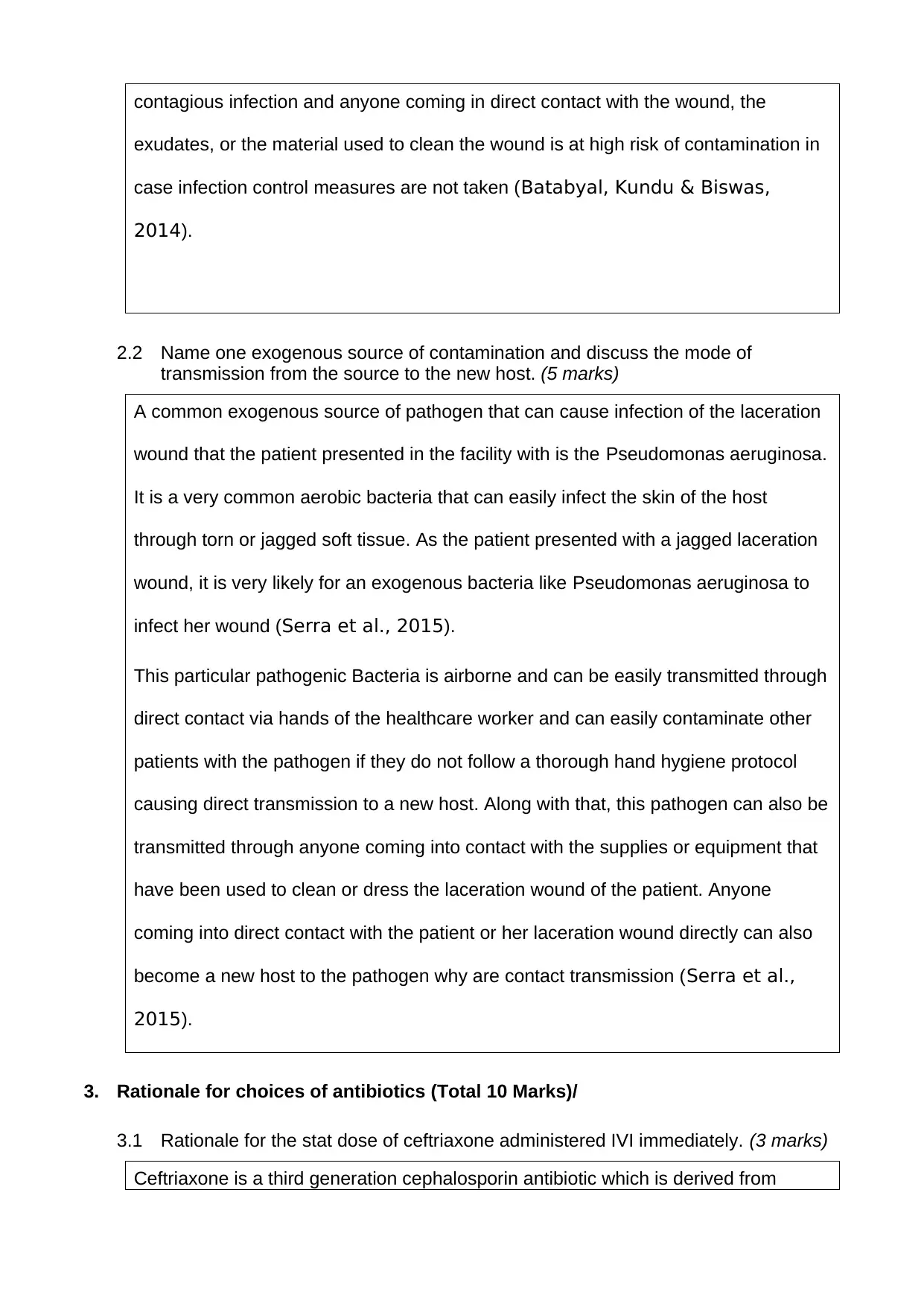
contagious infection and anyone coming in direct contact with the wound, the
exudates, or the material used to clean the wound is at high risk of contamination in
case infection control measures are not taken (Batabyal, Kundu & Biswas,
2014).
2.2 Name one exogenous source of contamination and discuss the mode of
transmission from the source to the new host. (5 marks)
A common exogenous source of pathogen that can cause infection of the laceration
wound that the patient presented in the facility with is the Pseudomonas aeruginosa.
It is a very common aerobic bacteria that can easily infect the skin of the host
through torn or jagged soft tissue. As the patient presented with a jagged laceration
wound, it is very likely for an exogenous bacteria like Pseudomonas aeruginosa to
infect her wound (Serra et al., 2015).
This particular pathogenic Bacteria is airborne and can be easily transmitted through
direct contact via hands of the healthcare worker and can easily contaminate other
patients with the pathogen if they do not follow a thorough hand hygiene protocol
causing direct transmission to a new host. Along with that, this pathogen can also be
transmitted through anyone coming into contact with the supplies or equipment that
have been used to clean or dress the laceration wound of the patient. Anyone
coming into direct contact with the patient or her laceration wound directly can also
become a new host to the pathogen why are contact transmission (Serra et al.,
2015).
3. Rationale for choices of antibiotics (Total 10 Marks)/
3.1 Rationale for the stat dose of ceftriaxone administered IVI immediately. (3 marks)
Ceftriaxone is a third generation cephalosporin antibiotic which is derived from
exudates, or the material used to clean the wound is at high risk of contamination in
case infection control measures are not taken (Batabyal, Kundu & Biswas,
2014).
2.2 Name one exogenous source of contamination and discuss the mode of
transmission from the source to the new host. (5 marks)
A common exogenous source of pathogen that can cause infection of the laceration
wound that the patient presented in the facility with is the Pseudomonas aeruginosa.
It is a very common aerobic bacteria that can easily infect the skin of the host
through torn or jagged soft tissue. As the patient presented with a jagged laceration
wound, it is very likely for an exogenous bacteria like Pseudomonas aeruginosa to
infect her wound (Serra et al., 2015).
This particular pathogenic Bacteria is airborne and can be easily transmitted through
direct contact via hands of the healthcare worker and can easily contaminate other
patients with the pathogen if they do not follow a thorough hand hygiene protocol
causing direct transmission to a new host. Along with that, this pathogen can also be
transmitted through anyone coming into contact with the supplies or equipment that
have been used to clean or dress the laceration wound of the patient. Anyone
coming into direct contact with the patient or her laceration wound directly can also
become a new host to the pathogen why are contact transmission (Serra et al.,
2015).
3. Rationale for choices of antibiotics (Total 10 Marks)/
3.1 Rationale for the stat dose of ceftriaxone administered IVI immediately. (3 marks)
Ceftriaxone is a third generation cephalosporin antibiotic which is derived from
⊘ This is a preview!⊘
Do you want full access?
Subscribe today to unlock all pages.

Trusted by 1+ million students worldwide
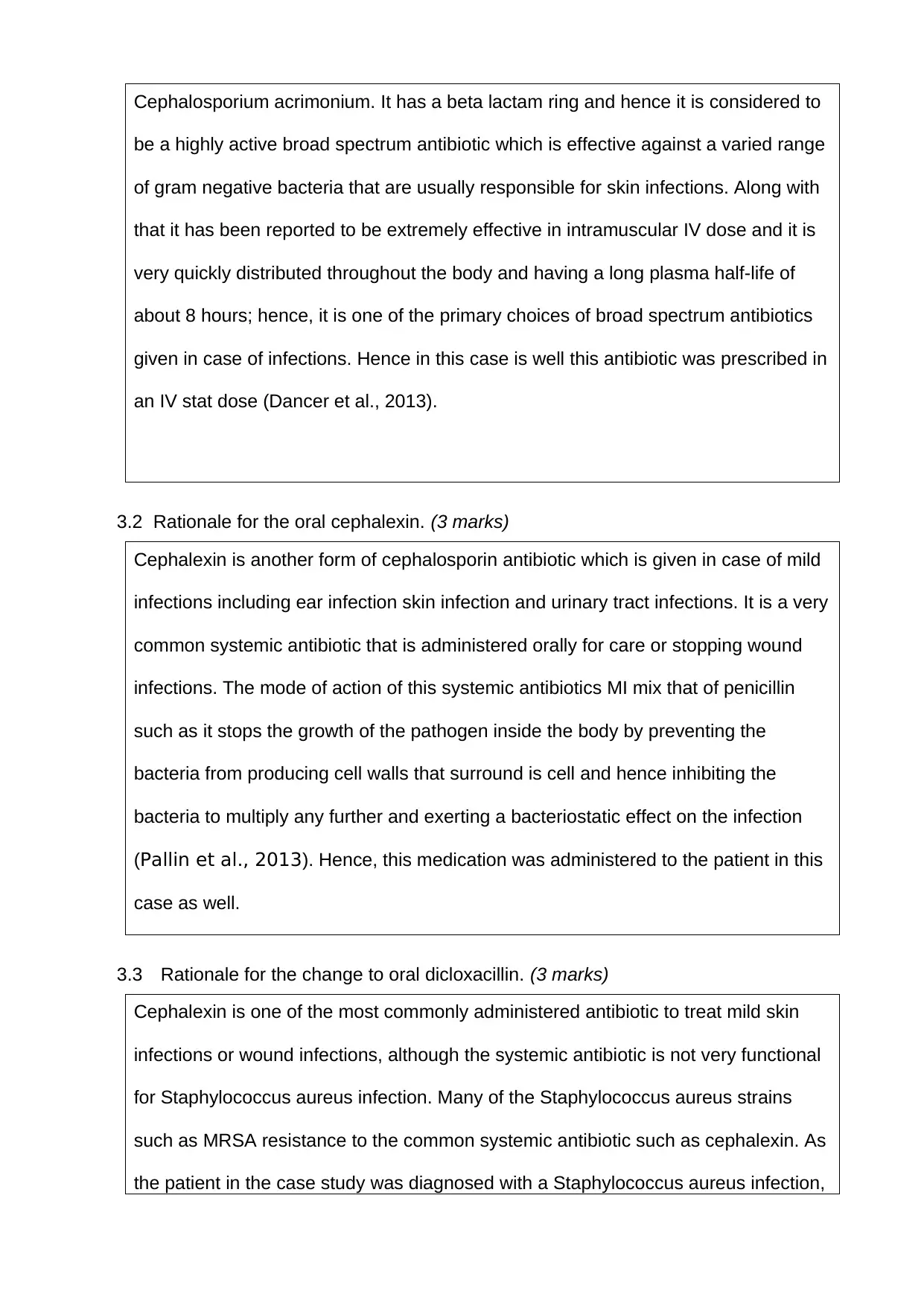
Cephalosporium acrimonium. It has a beta lactam ring and hence it is considered to
be a highly active broad spectrum antibiotic which is effective against a varied range
of gram negative bacteria that are usually responsible for skin infections. Along with
that it has been reported to be extremely effective in intramuscular IV dose and it is
very quickly distributed throughout the body and having a long plasma half-life of
about 8 hours; hence, it is one of the primary choices of broad spectrum antibiotics
given in case of infections. Hence in this case is well this antibiotic was prescribed in
an IV stat dose (Dancer et al., 2013).
3.2 Rationale for the oral cephalexin. (3 marks)
Cephalexin is another form of cephalosporin antibiotic which is given in case of mild
infections including ear infection skin infection and urinary tract infections. It is a very
common systemic antibiotic that is administered orally for care or stopping wound
infections. The mode of action of this systemic antibiotics MI mix that of penicillin
such as it stops the growth of the pathogen inside the body by preventing the
bacteria from producing cell walls that surround is cell and hence inhibiting the
bacteria to multiply any further and exerting a bacteriostatic effect on the infection
(Pallin et al., 2013). Hence, this medication was administered to the patient in this
case as well.
3.3 Rationale for the change to oral dicloxacillin. (3 marks)
Cephalexin is one of the most commonly administered antibiotic to treat mild skin
infections or wound infections, although the systemic antibiotic is not very functional
for Staphylococcus aureus infection. Many of the Staphylococcus aureus strains
such as MRSA resistance to the common systemic antibiotic such as cephalexin. As
the patient in the case study was diagnosed with a Staphylococcus aureus infection,
be a highly active broad spectrum antibiotic which is effective against a varied range
of gram negative bacteria that are usually responsible for skin infections. Along with
that it has been reported to be extremely effective in intramuscular IV dose and it is
very quickly distributed throughout the body and having a long plasma half-life of
about 8 hours; hence, it is one of the primary choices of broad spectrum antibiotics
given in case of infections. Hence in this case is well this antibiotic was prescribed in
an IV stat dose (Dancer et al., 2013).
3.2 Rationale for the oral cephalexin. (3 marks)
Cephalexin is another form of cephalosporin antibiotic which is given in case of mild
infections including ear infection skin infection and urinary tract infections. It is a very
common systemic antibiotic that is administered orally for care or stopping wound
infections. The mode of action of this systemic antibiotics MI mix that of penicillin
such as it stops the growth of the pathogen inside the body by preventing the
bacteria from producing cell walls that surround is cell and hence inhibiting the
bacteria to multiply any further and exerting a bacteriostatic effect on the infection
(Pallin et al., 2013). Hence, this medication was administered to the patient in this
case as well.
3.3 Rationale for the change to oral dicloxacillin. (3 marks)
Cephalexin is one of the most commonly administered antibiotic to treat mild skin
infections or wound infections, although the systemic antibiotic is not very functional
for Staphylococcus aureus infection. Many of the Staphylococcus aureus strains
such as MRSA resistance to the common systemic antibiotic such as cephalexin. As
the patient in the case study was diagnosed with a Staphylococcus aureus infection,
Paraphrase This Document
Need a fresh take? Get an instant paraphrase of this document with our AI Paraphraser
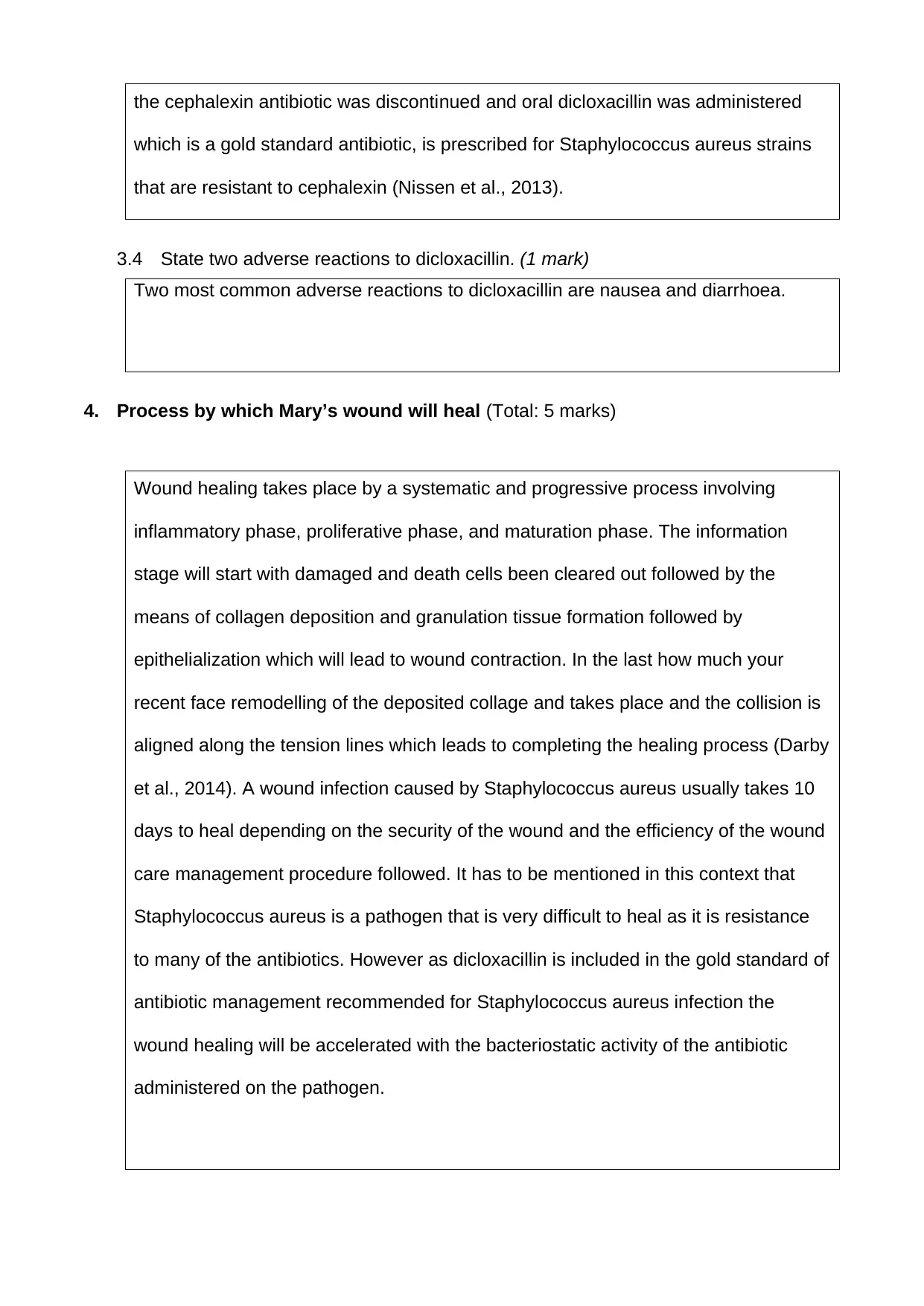
the cephalexin antibiotic was discontinued and oral dicloxacillin was administered
which is a gold standard antibiotic, is prescribed for Staphylococcus aureus strains
that are resistant to cephalexin (Nissen et al., 2013).
3.4 State two adverse reactions to dicloxacillin. (1 mark)
Two most common adverse reactions to dicloxacillin are nausea and diarrhoea.
4. Process by which Mary’s wound will heal (Total: 5 marks)
Wound healing takes place by a systematic and progressive process involving
inflammatory phase, proliferative phase, and maturation phase. The information
stage will start with damaged and death cells been cleared out followed by the
means of collagen deposition and granulation tissue formation followed by
epithelialization which will lead to wound contraction. In the last how much your
recent face remodelling of the deposited collage and takes place and the collision is
aligned along the tension lines which leads to completing the healing process (Darby
et al., 2014). A wound infection caused by Staphylococcus aureus usually takes 10
days to heal depending on the security of the wound and the efficiency of the wound
care management procedure followed. It has to be mentioned in this context that
Staphylococcus aureus is a pathogen that is very difficult to heal as it is resistance
to many of the antibiotics. However as dicloxacillin is included in the gold standard of
antibiotic management recommended for Staphylococcus aureus infection the
wound healing will be accelerated with the bacteriostatic activity of the antibiotic
administered on the pathogen.
which is a gold standard antibiotic, is prescribed for Staphylococcus aureus strains
that are resistant to cephalexin (Nissen et al., 2013).
3.4 State two adverse reactions to dicloxacillin. (1 mark)
Two most common adverse reactions to dicloxacillin are nausea and diarrhoea.
4. Process by which Mary’s wound will heal (Total: 5 marks)
Wound healing takes place by a systematic and progressive process involving
inflammatory phase, proliferative phase, and maturation phase. The information
stage will start with damaged and death cells been cleared out followed by the
means of collagen deposition and granulation tissue formation followed by
epithelialization which will lead to wound contraction. In the last how much your
recent face remodelling of the deposited collage and takes place and the collision is
aligned along the tension lines which leads to completing the healing process (Darby
et al., 2014). A wound infection caused by Staphylococcus aureus usually takes 10
days to heal depending on the security of the wound and the efficiency of the wound
care management procedure followed. It has to be mentioned in this context that
Staphylococcus aureus is a pathogen that is very difficult to heal as it is resistance
to many of the antibiotics. However as dicloxacillin is included in the gold standard of
antibiotic management recommended for Staphylococcus aureus infection the
wound healing will be accelerated with the bacteriostatic activity of the antibiotic
administered on the pathogen.

⊘ This is a preview!⊘
Do you want full access?
Subscribe today to unlock all pages.

Trusted by 1+ million students worldwide
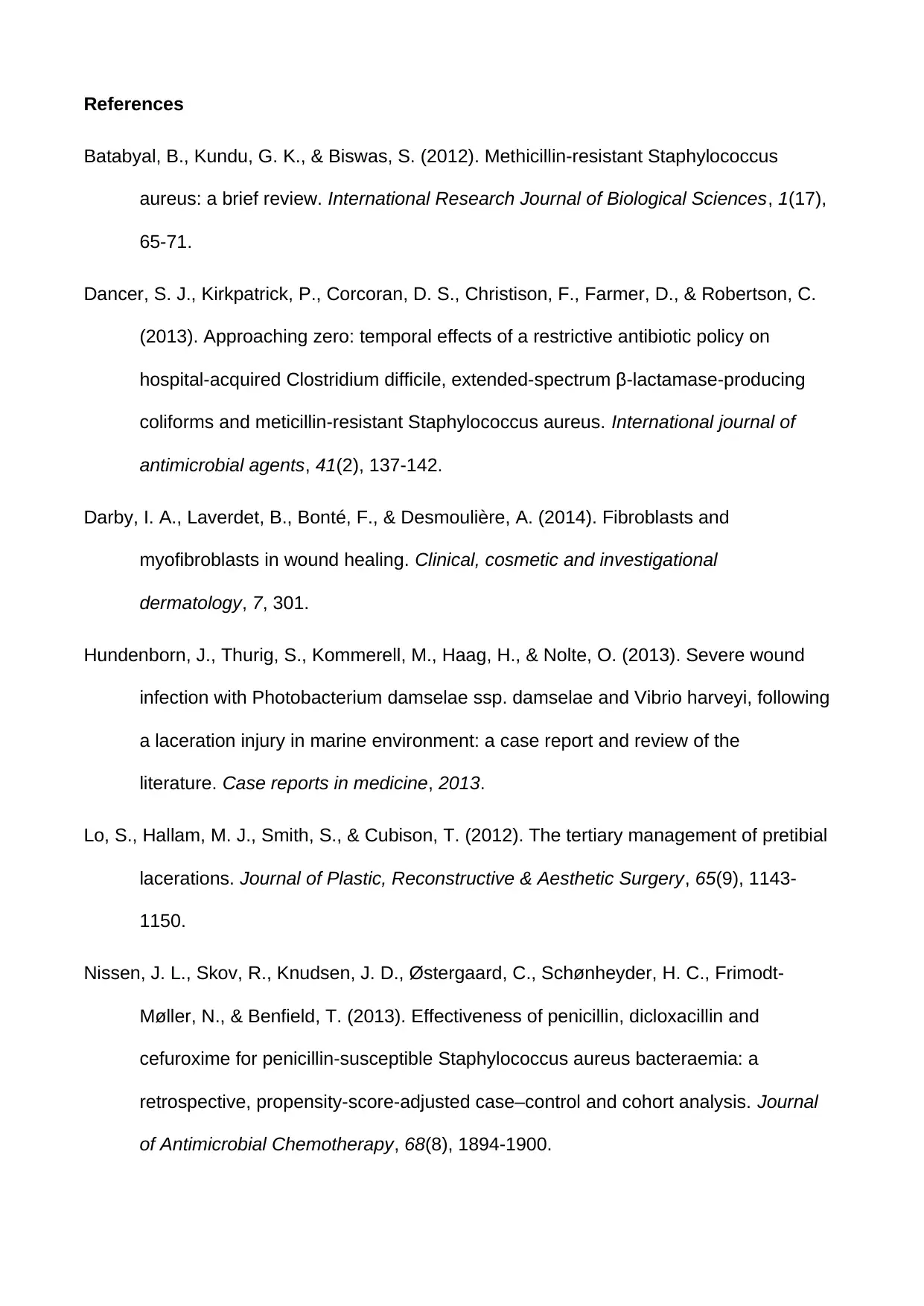
References
Batabyal, B., Kundu, G. K., & Biswas, S. (2012). Methicillin-resistant Staphylococcus
aureus: a brief review. International Research Journal of Biological Sciences, 1(17),
65-71.
Dancer, S. J., Kirkpatrick, P., Corcoran, D. S., Christison, F., Farmer, D., & Robertson, C.
(2013). Approaching zero: temporal effects of a restrictive antibiotic policy on
hospital-acquired Clostridium difficile, extended-spectrum β-lactamase-producing
coliforms and meticillin-resistant Staphylococcus aureus. International journal of
antimicrobial agents, 41(2), 137-142.
Darby, I. A., Laverdet, B., Bonté, F., & Desmoulière, A. (2014). Fibroblasts and
myofibroblasts in wound healing. Clinical, cosmetic and investigational
dermatology, 7, 301.
Hundenborn, J., Thurig, S., Kommerell, M., Haag, H., & Nolte, O. (2013). Severe wound
infection with Photobacterium damselae ssp. damselae and Vibrio harveyi, following
a laceration injury in marine environment: a case report and review of the
literature. Case reports in medicine, 2013.
Lo, S., Hallam, M. J., Smith, S., & Cubison, T. (2012). The tertiary management of pretibial
lacerations. Journal of Plastic, Reconstructive & Aesthetic Surgery, 65(9), 1143-
1150.
Nissen, J. L., Skov, R., Knudsen, J. D., Østergaard, C., Schønheyder, H. C., Frimodt-
Møller, N., & Benfield, T. (2013). Effectiveness of penicillin, dicloxacillin and
cefuroxime for penicillin-susceptible Staphylococcus aureus bacteraemia: a
retrospective, propensity-score-adjusted case–control and cohort analysis. Journal
of Antimicrobial Chemotherapy, 68(8), 1894-1900.
Batabyal, B., Kundu, G. K., & Biswas, S. (2012). Methicillin-resistant Staphylococcus
aureus: a brief review. International Research Journal of Biological Sciences, 1(17),
65-71.
Dancer, S. J., Kirkpatrick, P., Corcoran, D. S., Christison, F., Farmer, D., & Robertson, C.
(2013). Approaching zero: temporal effects of a restrictive antibiotic policy on
hospital-acquired Clostridium difficile, extended-spectrum β-lactamase-producing
coliforms and meticillin-resistant Staphylococcus aureus. International journal of
antimicrobial agents, 41(2), 137-142.
Darby, I. A., Laverdet, B., Bonté, F., & Desmoulière, A. (2014). Fibroblasts and
myofibroblasts in wound healing. Clinical, cosmetic and investigational
dermatology, 7, 301.
Hundenborn, J., Thurig, S., Kommerell, M., Haag, H., & Nolte, O. (2013). Severe wound
infection with Photobacterium damselae ssp. damselae and Vibrio harveyi, following
a laceration injury in marine environment: a case report and review of the
literature. Case reports in medicine, 2013.
Lo, S., Hallam, M. J., Smith, S., & Cubison, T. (2012). The tertiary management of pretibial
lacerations. Journal of Plastic, Reconstructive & Aesthetic Surgery, 65(9), 1143-
1150.
Nissen, J. L., Skov, R., Knudsen, J. D., Østergaard, C., Schønheyder, H. C., Frimodt-
Møller, N., & Benfield, T. (2013). Effectiveness of penicillin, dicloxacillin and
cefuroxime for penicillin-susceptible Staphylococcus aureus bacteraemia: a
retrospective, propensity-score-adjusted case–control and cohort analysis. Journal
of Antimicrobial Chemotherapy, 68(8), 1894-1900.
Paraphrase This Document
Need a fresh take? Get an instant paraphrase of this document with our AI Paraphraser
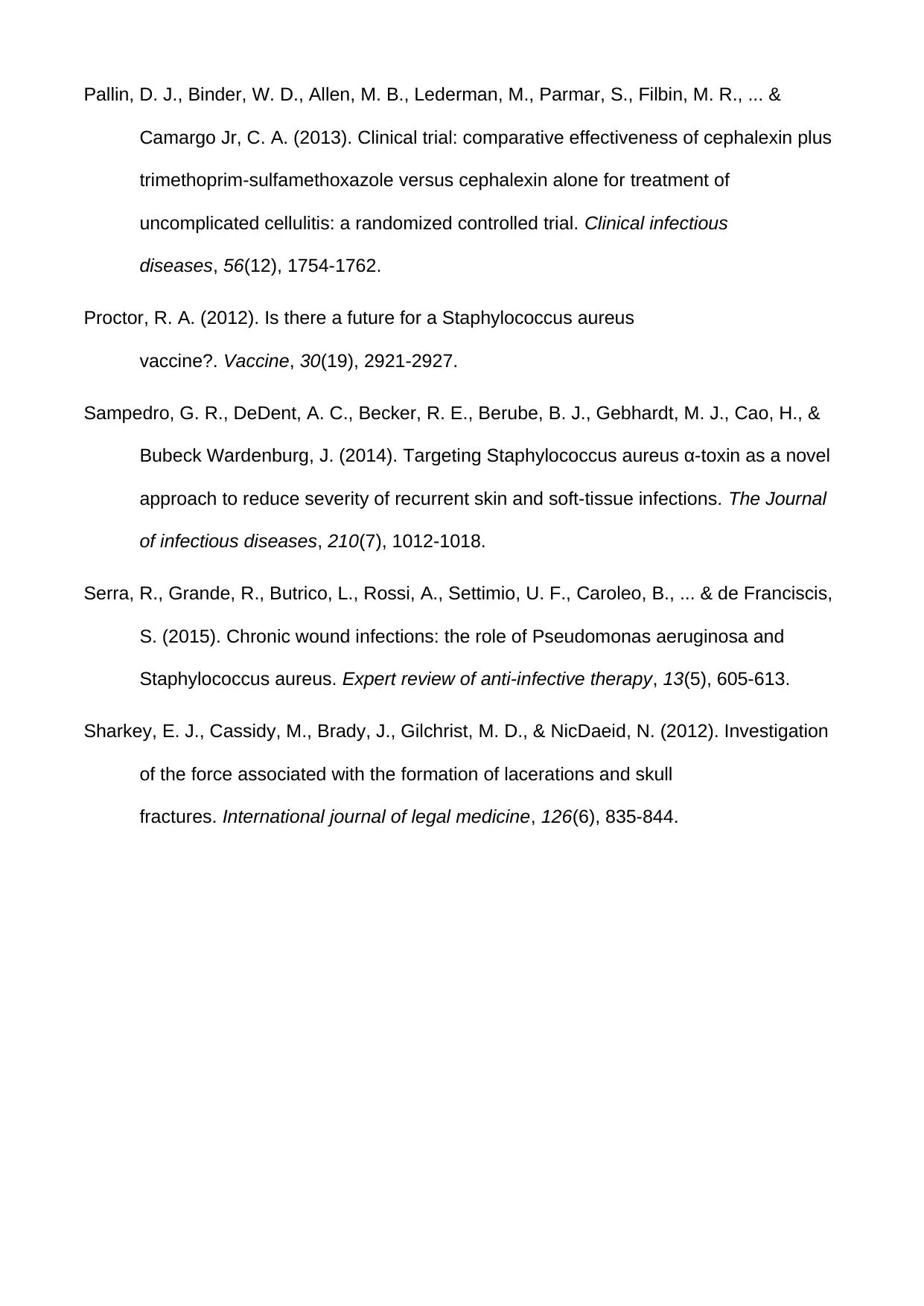
Pallin, D. J., Binder, W. D., Allen, M. B., Lederman, M., Parmar, S., Filbin, M. R., ... &
Camargo Jr, C. A. (2013). Clinical trial: comparative effectiveness of cephalexin plus
trimethoprim-sulfamethoxazole versus cephalexin alone for treatment of
uncomplicated cellulitis: a randomized controlled trial. Clinical infectious
diseases, 56(12), 1754-1762.
Proctor, R. A. (2012). Is there a future for a Staphylococcus aureus
vaccine?. Vaccine, 30(19), 2921-2927.
Sampedro, G. R., DeDent, A. C., Becker, R. E., Berube, B. J., Gebhardt, M. J., Cao, H., &
Bubeck Wardenburg, J. (2014). Targeting Staphylococcus aureus α-toxin as a novel
approach to reduce severity of recurrent skin and soft-tissue infections. The Journal
of infectious diseases, 210(7), 1012-1018.
Serra, R., Grande, R., Butrico, L., Rossi, A., Settimio, U. F., Caroleo, B., ... & de Franciscis,
S. (2015). Chronic wound infections: the role of Pseudomonas aeruginosa and
Staphylococcus aureus. Expert review of anti-infective therapy, 13(5), 605-613.
Sharkey, E. J., Cassidy, M., Brady, J., Gilchrist, M. D., & NicDaeid, N. (2012). Investigation
of the force associated with the formation of lacerations and skull
fractures. International journal of legal medicine, 126(6), 835-844.
Camargo Jr, C. A. (2013). Clinical trial: comparative effectiveness of cephalexin plus
trimethoprim-sulfamethoxazole versus cephalexin alone for treatment of
uncomplicated cellulitis: a randomized controlled trial. Clinical infectious
diseases, 56(12), 1754-1762.
Proctor, R. A. (2012). Is there a future for a Staphylococcus aureus
vaccine?. Vaccine, 30(19), 2921-2927.
Sampedro, G. R., DeDent, A. C., Becker, R. E., Berube, B. J., Gebhardt, M. J., Cao, H., &
Bubeck Wardenburg, J. (2014). Targeting Staphylococcus aureus α-toxin as a novel
approach to reduce severity of recurrent skin and soft-tissue infections. The Journal
of infectious diseases, 210(7), 1012-1018.
Serra, R., Grande, R., Butrico, L., Rossi, A., Settimio, U. F., Caroleo, B., ... & de Franciscis,
S. (2015). Chronic wound infections: the role of Pseudomonas aeruginosa and
Staphylococcus aureus. Expert review of anti-infective therapy, 13(5), 605-613.
Sharkey, E. J., Cassidy, M., Brady, J., Gilchrist, M. D., & NicDaeid, N. (2012). Investigation
of the force associated with the formation of lacerations and skull
fractures. International journal of legal medicine, 126(6), 835-844.
1 out of 8
Related Documents
Your All-in-One AI-Powered Toolkit for Academic Success.
+13062052269
info@desklib.com
Available 24*7 on WhatsApp / Email
![[object Object]](/_next/static/media/star-bottom.7253800d.svg)
Unlock your academic potential
Copyright © 2020–2025 A2Z Services. All Rights Reserved. Developed and managed by ZUCOL.




